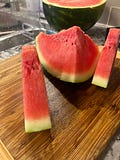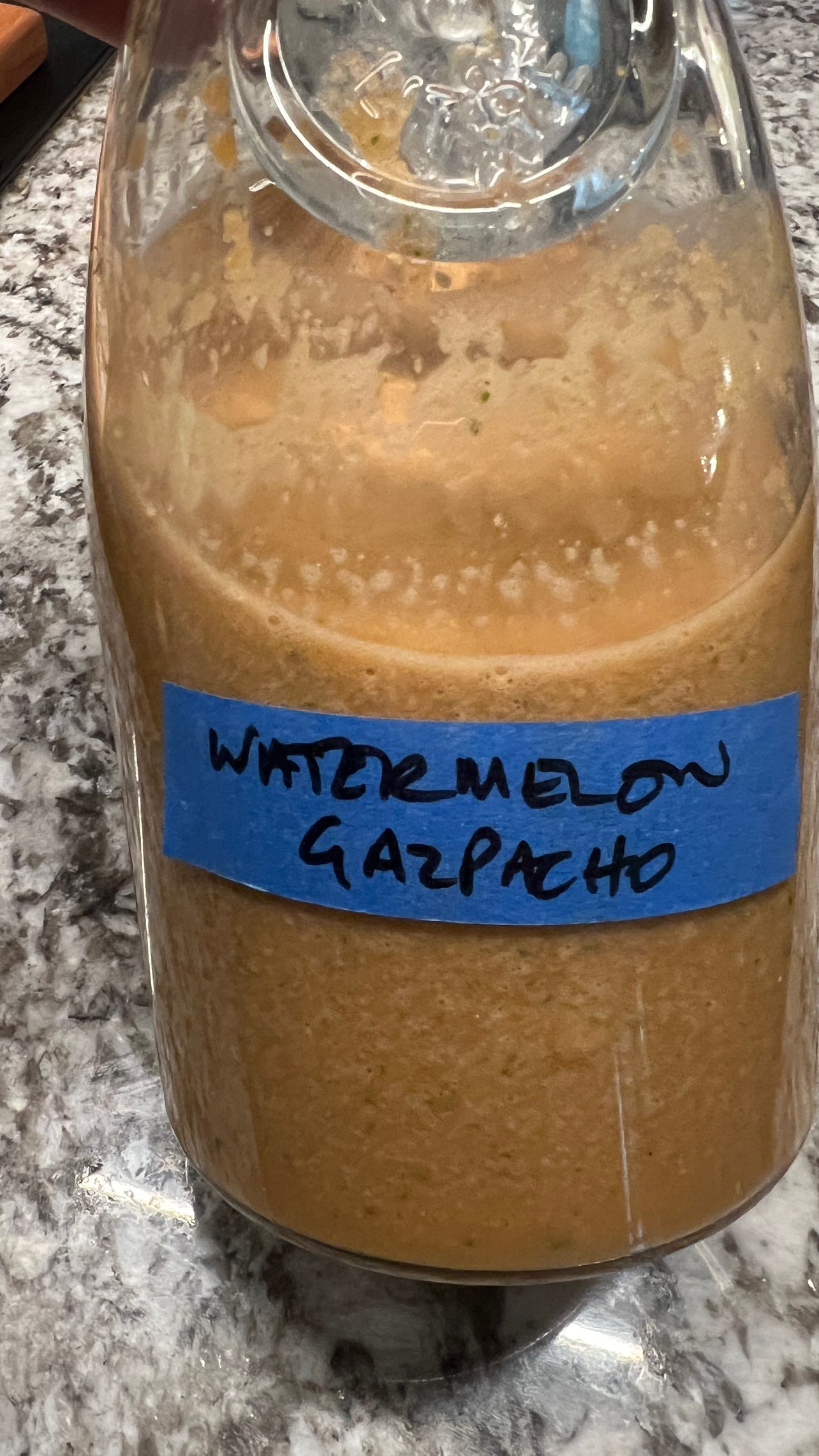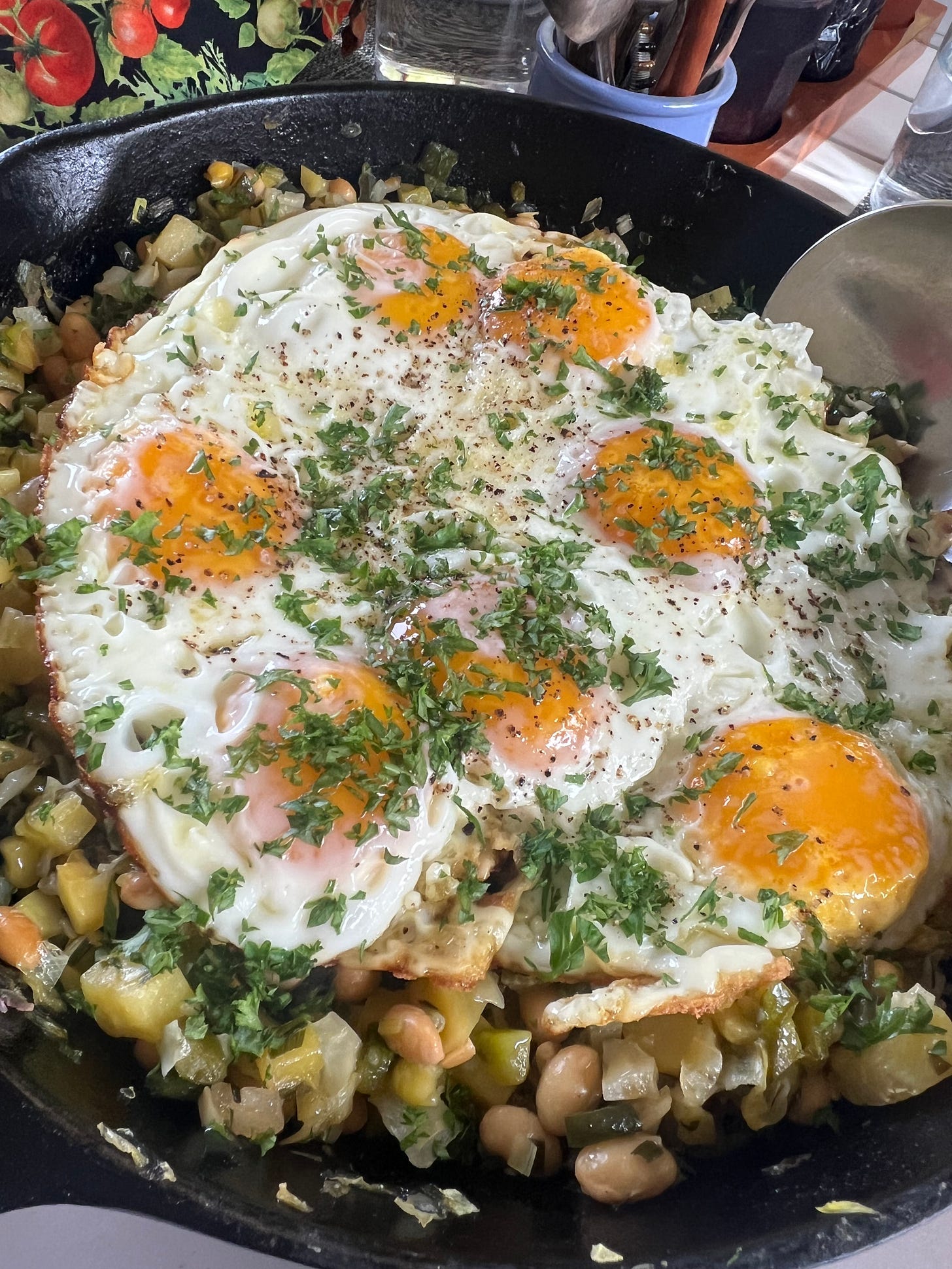Issue #174: Watermelon Gazpacho and More
Mealy Melons, A Refreshing Soup, Beans is How, Sufferin’ Succotash
I know most of us think of gazpacho—the chilled Spanish vegetable and bread soup that’s been used to dramatic effect by Almodóvar—as a summertime specialty. Considering how well it refreshes on a hot, sunny Andalucian day, it’s hard to argue. But I’m here to suggest to you that now is also a good time to make gazpacho, too. Hear me out.
During this transition period from summer to fall, farm stands in the northeast are in the midst of a seasonal identity crisis of sorts. Among heirloom tomatoes and bunches of basil, the first pumpkins and squash have appeared. Pears and apples are squeezing out plums for space.
To make matters more confusing, the other day Edgewater Farm down the road from us had a bumper late-harvest crop of strawberries and raspberries. They also have a surfeit of watermelons they’ve been trying to pawn off on those of us with CSA shares and anyone willing to take their all-you-can-carry watermelon challenge. (See Nate’s attempt in Issue #173)
Fall berries aside, currently summer fruit is, for the most part, past its prime. Tomatoes at this time of year tend to be overgrown and overripe. The plums are soft. And those watermelons, as we recently discovered, can be mealy and flaccid.
Unable to simply dispose of a couple of sad watermelons on our compost pile last week, I decided to do something with them: watermelon gazpacho. Just as a watermelon, tomato, and feta salad (Issue #61) brings out a watermelon’s vegetal qualities, watermelon gazpacho underscores the fruit’s cucumber cousinship—they are both members of the Cucurbitaceae family. The subtle sweetness and body of watermelon flesh brings a delicate character to the soup. The immediate reaction of my guests after taking a first sip, “Oh my god, what is this?!”
To keep the texture of my watermelon gazpacho light, I don’t add stale bread to this gazpacho, a crucial element in more traditional versions. But I do add some toasted almonds to give the soup body and texture. Rather than serve the soup in a bowl with a spoon, I like to drink this gazpacho over ice from a glass, a kind of healthy virgin cocktail or smoothy, or as I like to say, “salad in glass.”
RECIPE: Watermelon Gazpacho
Makes 2 quarts, about 8 servings
6 cups watermelon, cubed and seeded (about 1 ½ pounds)
2 medium ripe tomatoes, cored and diced (about ¾ pound)
1 medium cucumber, peeled (if waxy) and seeded (if seedy), diced (about ¾ pound)
½ medium red onion, diced
½ cup toasted blanched almonds, preferably Marcona
2 teaspoons kosher salt
Freshly ground black pepper
Pinch mild red chili powder, such as piment d’espelette or Aleppo
3 tablespoons sherry or apple cider vinegar, plus more to taste
¼ cup extra-virgin olive oil
In a large bowl, combine the watermelon, tomato, cucumber, onion, almonds, salt, pepper, and chili. Toss to evenly distribute the ingredients, and let sit out on the counter for at least an hour and preferably more to macerate.
Transfer the marinated mixture to a large blender. (Work in batches, if necessary.) Pulse everything to grind and then whiz to liquify. You should have a frothy mixture. Add the vinegar and olive oil and continue blending until smooth. Taste and adjust the seasoning with additional vinegar, salt, and pepper, as you like.
Serve over ice in large glasses or in chilled bowls.
Beans on the Menu Challenge NYC 2024
Last year, my Kitchen Sense consultancy helped inaugurate the first Beans on the Menu Challenge in New York City during the UN General Assembly and Climate Week festivities that take place during the third week of September (see Issue #120). We signed up more than 50 chefs and restaurants across the five boroughs to put beans on the menu and used social media to tout their gastronomic goodness, as well as their affordability, positive environmental impact, and healthfulness—all part of the global Beans is How campaign to double consumption of beans and other pulses around the world by 2028.
Well, here we are again, it’s Climate Week NYC, and the Menu Challenge is back. You can see a complete list of this year’s participating restaurants and other Beans is How partners here on the Menu Challenge website.
And more importantly, why not put beans on YOUR menu in solidarity with the movement? That’s the point, to get everyone to eat more beans.
Here’s my “recipe” for succotash, a sort of vegetable and bean hash, which is ideal to make at this time of year when sweet corn is still plentiful and fresh lima beans are available. If you think you hate lima beans, I would encourage you to find fresh ones, which are creamy and buttery and as delicious as a bean can be. Southern New Jersey happens to be a global lima bean growing capital, so we can find them in pretty easily in the Union Square greenmarket.
Though corn and limas are traditional in succotash, any shelling bean, fresh or dried, will work well. Try cranberry beans, borlotti beans, navy beans, or even favas. This weekend I happened to have cooked up some dried Finger Lakes yellow peas, and so that’s what I used. Have fun with it.
RECIPE: Mitchell’s Succotash
Serves 4 to 6
Extra-virgin olive oil
1 ounce bacon, pancetta, fatty ham, chopped, or 1 tablespoon bacon grease
1 medium onion, diced
2 or 3 garlic scapes, chopped (optional)
Salt
2 small potatoes, peeled and finely diced (optional)
1 cup fresh lima or other shelling beans, or cooked dried beans, such as cannellini, cranberry, navy, yellow peas, or others
1 sweet pepper, such as yellow or red bell pepper, Jimmy Nardello, Carmen, or poblano, seeded and diced
1 cup finely diced cabbage or other cruciferous vegetable, such as Brussels sprouts, turnip, cauliflower, or kale
1 large zucchini or yellow squash, diced (optional)
2 or 3 ears fresh corn, shucked
2 scallions and/or a handful of chives
Handful of parsley and/or other herbs, chopped
Freshly ground black pepper
6 eggs, fried or poached (see Issue #12)
In a large cast-iron skillet, heat a couple of tablespoons of olive oil with the bacon or other fat. When hot and the fat has rendered, add the onion and garlic scapes, if using, and a pinch of salt, and sauté until soft. Add the potatoes and beans, another pinch of salt, and continue cooking until you can see the flesh of the potato begin to lighten, about 5 minutes. If the potatoes stick to the pan, just scrape them off.
Add the pepper and cabbage and continue cooking, stirring often, until the cabbage wilts, 5 minutes or so. Add the zucchini, if using, and cook until it softens. Add the corn and scallions, and cook to heat through. Add a pinch of salt, all but a tablespoon of the herbs, and a generous amount of black pepper, and continue cooking until the vegetables come together in a soft, succulent hash, maybe 8 to 10 minutes. Meanwhile, prepare your eggs. Taste and adjust the seasoning. Top with the eggs, fried or poached, a sprinkle of salt, black pepper, and the chopped herbs you held back.






